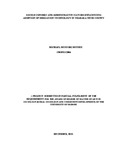| dc.description.abstract | The importance of irrigation in increasing agricultural productivity in arid and semi arid
areas in Kenya cannot be underscored. Tharaka-nithi county is one of the forty seven (47)
counties created by the Kenya constitution 2010 that has priotised irrigation tehnology
development in her County Development Intergrated Plan 2013-2017. An estimated 80%
of the county population is engaged in agricultural activities. The semi-arid (lower zone)
covering Tharaka North and South subcounties receives less, erratic and unreliable
rainfall for agricultural production. Crop farming is characterized by frequent crop
failures especially in the two subcounties. Several efforts and resources from both the
government and donor community have been expended in promotion of irrigation
technology to increase food production over the years. Despite this investment, adoption
levels have remained low and largely unsustainable (Ngigi, 1999).
In a bid to explain this gap, this study sought to examine farmers perceptions, attitudes,
socio-economic and administrative factors that affect adoption of irrigation technologies
in the county. Data for this study was collected through secondary data review of existing
information in similar studies and reports, primary data was collected through survey
using structured questionnaire, interview with key informants was guided by structured
guides and focus groups discussion guides were used for the focus groups. Data was
collected between the period of June – July, 2014 across six irrigation groups comprising
of both adopters and non adopters. The data was then cleaned, coded and analysed using
SPSS descriptive and inferatial statistics, t-tests were carried out to establish correlation
coefficient and significance.
The results illustrated that age, gender, size of land cultivated, years of residence and
education level did not have significant relationship with decision to adopt or not adopt
irrigation technology implying that they overally didn’t influence adoption decisions. On
the other hand, membership to farmers groups, information access, land tenure and
external support had a significant relationship, implying that they really affected farmers
decision to adopt or not adopt irrigation technology. Further, the ten socio-economic
variables viz; age, sex, marital status, education level, size of land owned, distance to the
market, access to credit and external support when taken together were found to be
significant in predicting farmer’s adoption of irrigation technology. | en_US |

